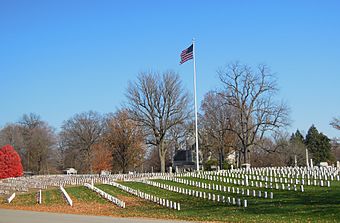Crown Hill National Cemetery facts for kids
Quick facts for kids |
|
|
Crown Hill National Cemetery
|
|

Gravestones in the cemetery (2012).
|
|
| Location | Indianapolis, Indiana |
|---|---|
| Built | 1866 |
| MPS | Civil War Era National Cemeteries MPS |
| NRHP reference No. | 99000486 |
| Added to NRHP | April 29, 1999 |
The Crown Hill National Cemetery is a special burial ground in Indianapolis, Marion County, Indiana. It's a U.S. National Cemetery, which means it's managed by the government for military members. This cemetery was created in 1866. It's located inside a larger, private cemetery called Crown Hill Cemetery.
The National Cemetery is about 1.4 acres in size. It was set up to be a final resting place for Union soldiers who fought in the American Civil War. Before this cemetery, soldiers who died in Indianapolis were buried at Greenlawn Cemetery. The first Union soldier was moved from Greenlawn to Crown Hill National Cemetery on October 19, 1866. By November 1866, 707 soldiers had been moved.
The first Union veteran was buried here on October 7, 1869. The last Union veteran burial happened on November 16, 1898. As of 1998, there were 795 burials in the National Cemetery. The cemetery has marked graves and special memorials. One monument was dedicated on May 30, 1889. There are also plaques with verses from a poem called "Bivouac of the Dead." Crown Hill Cemetery, including the National Cemetery, is listed on the National Register of Historic Places.
Contents
A Place for Heroes: History of the Cemetery
Before the Crown Hill National Cemetery was built, Indianapolis didn't have a specific place to bury Union soldiers. During the American Civil War, Indianapolis was a major center for moving troops. Soldiers who died in camps or hospitals were first buried at Greenlawn Cemetery. Even Confederate prisoners who died at Camp Morton, a large prison camp, were buried there.
By 1863, Greenlawn Cemetery was getting full. So, a group of local business people started Crown Hill Cemetery. This new, private cemetery opened on October 22, 1863. It was located northwest of downtown Indianapolis. In 1866, the U.S. government decided to create a National Cemetery in Indianapolis. They arranged to move the soldiers from Greenlawn.
Choosing the Location
The National Cemetery was set up on 1.4 acres within Crown Hill Cemetery. Brigadier General James A. Ekin and Oliver P. Morton, who was the governor of Indiana, helped choose the spot. This area is known as Section 10. Crown Hill Cemetery first offered to donate the land. But the government ended up buying it for $5,000.
Moving the Soldiers
Within a few months, Union soldiers buried at Greenlawn were moved. On October 19, 1866, Matthew Quigley was the first of hundreds of Union soldiers moved to Crown Hill. By November 1866, 707 soldiers had been moved. They were buried in special coffins, spaced two feet apart. Not all the soldiers buried here were from Indiana. The cemetery also holds the remains of thirty-six unknown soldiers.
First Memorial Day
On May 30, 1868, Crown Hill took part in the country's first Memorial Day ceremonies. About 10,000 people came to the celebrations at Crown Hill. This started an annual tradition that continues today.
Later Burials and Expansions
On October 7, 1869, John F. Wilson became the first Union veteran to be buried in the National Cemetery. Eighty-five other veterans were buried in the remaining plots. The last Civil War soldier burial in this section was on November 16, 1898. This was John H. Tull.
In 1889, the government wanted to expand the cemetery for more veteran burials. Crown Hill suggested a nearby section, but the government didn't act on it. Later, in 1899, Crown Hill allowed members of the Grand Army of the Republic (a group for Union veterans) to be buried in Section 9, next to the National Cemetery. Famous Civil War generals like Edward Richard Sprigg Canby and Jefferson C. Davis are buried nearby.
The last burial in Crown Hill's National Cemetery was on October 27, 1969. This was Major Robert W. Hayes, who died in Vietnam. As of 1998, there were 795 burial sites. The Crown Hill National Cemetery was added to the National Register of Historic Places on April 29, 1999.
Confederate Soldiers' Burials
Besides the Union soldiers, Crown Hill Cemetery also has a burial site for Confederate prisoners of war. These prisoners died at Camp Morton, a large camp north of Indianapolis. In 1931, the bodies of these Confederate prisoners had to be moved from Greenlawn Cemetery. They were reburied in a mass grave at Crown Hill. This area is known as Confederate Mound in Section 32. In 1993, a Confederate Memorial was put up there. It has ten bronze plaques listing the names of 1,616 Confederate soldiers and sailors.
Art and Memorials
The National Cemetery has several memorials. The Major Robert Anderson Women's Relief Corps Number 44 put up a stone monument. It was dedicated on May 30, 1889. This monument honors unknown soldiers who died in the Civil War. Its inscription says: "In memory of the unknown dead who fell in our country's service in the War of the Union, A.D. 1861–1865."
There are also two other monuments made of cast-iron artillery. Three bronze plaques have verses from Theodore O'Hara's poem "Bivouac of the Dead." Another plaque shows the text of a federal law from 1864 that protects National Cemeteries. A flagpole was added in 1938.




